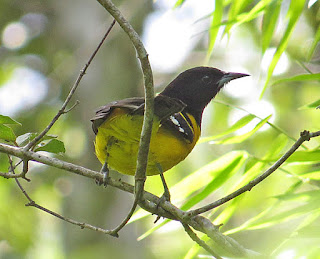On my fourth
day of leading field trips here, I did the nearby Sumidero Canyon, allowing me
to sleep in a couple more hours. The nearly sheer faces of the canyon down to
the Grijalva River reservoir offers one of the most impressive geologic vistas
I’ve ever seen.
The birding
here is interesting, with some dry forest and humid forest things, as well as
some local specialties, such as this Bar-winged Oriole, the only one we saw.
A very
scarce and local bird in Mexico is the Blue Seedeater, and this singing bird
was in the same place where Michael had it yesterday.
Yet another
specialty here is the odd but pretty Belted Flycatcher.
There are
lots of orioles here, the favored host of Bronzed Cowbird, so one sees them all
along the road.
At our last
stop a lively Canivet's Emerald came in to my Ferruginous Pygmy-Owl imitations.
We saw lots
of other cool things. This wooly caterpillar will eventually become a probably drab
moth.
This tiny
black metalmark was one of about seven that were only briefly landing on the
upper leaves of a small tree, then taking off and chasing around others,
sometimes all together in a whirring ball of energy. When they landed, they
opened the wings flat to grab the morning sunlight, and this is all we saw;
they matched nothing in the field guide.
So I sent
the photo to Jim Brock who recognized it as a Sarota, and he reminded me we had seem some do this at Cristalino
Jungle Lodge seven years ago. The vast majority of the time they are
encountered, they perch on lower vegetation with their wings closed and look
like this, my photo of Sarota myrtea,
White-cheeked Jewelmark from SE Peru.
One of the
participants spotted this stunning green grasshopper at the canyon vista, a
nymph of the very diverse genus Melanoplus.
Thanks to my contact Ricardo Marño-Pérez for the ID.
Also at the
canyon vista was this Chlosyne theona,
Theona Checkerspot.
What looked
like a scar on a tree trunk turned out to be a group of roosting 15-cm long morpho
caterpillars – perhaps White Morphos. During the night they climb to the
canopy to feed on foliage, then retreat before sunrise to avoid birds that prey
on them.
This leaf-mimic
katydid with a horn on its head is reminiscent of the genus Copiphora, but the flattened legs and
odd behavior suggests it might be something different. While slowly walking it
swayed to and fro, much like an American Woodcock. This is surely a tactic to
avoid notice by a bird, such as a trogon, who might take it for a swaying leaf.
On a later
afternoon stop we encountered the mother of all puddle parties. I estimated 20
species of butterfly in this one group.
Most of them were Chlosyne erodyle, the Guatemalan Patch or Erodyle Checkerspot, like
the one in the lower left, but I got only a couple photos of those I didn’t
recognize right away. This unusual medium-sized satyr is Taygetina kerea, Kerea Satyr.
This boldly
marked skipper is Antigonus corrosus,
Small Spurwing.
It’s been a
pretty good trip for orchids. Thanks to my contact Gerardo Salazar, who is
working on a book of orchids of Mexico, I now know this as Dichromanthus cinnabarinus. It looks very similar to a couple other
unrelated orchid genera that have independently evolved to attract hummingbirds
as pollinators (such as this Sacoila lanceolata), which we know thanks to an
amazing research paper that looked into the genetics by Gerardo and others.
Gerardo also
identified this orchid as a rarely seen Triphora
debilis, which was growing right in one of the trails. Even Gerardo has
never seen one live, and the university museum where he works at UNAM even
lacks a specimen!
By the way, Eric,
who led the Tapalapa field trip today, came back with a report of as many as
six Mountain Elaenias.























No comments:
Post a Comment